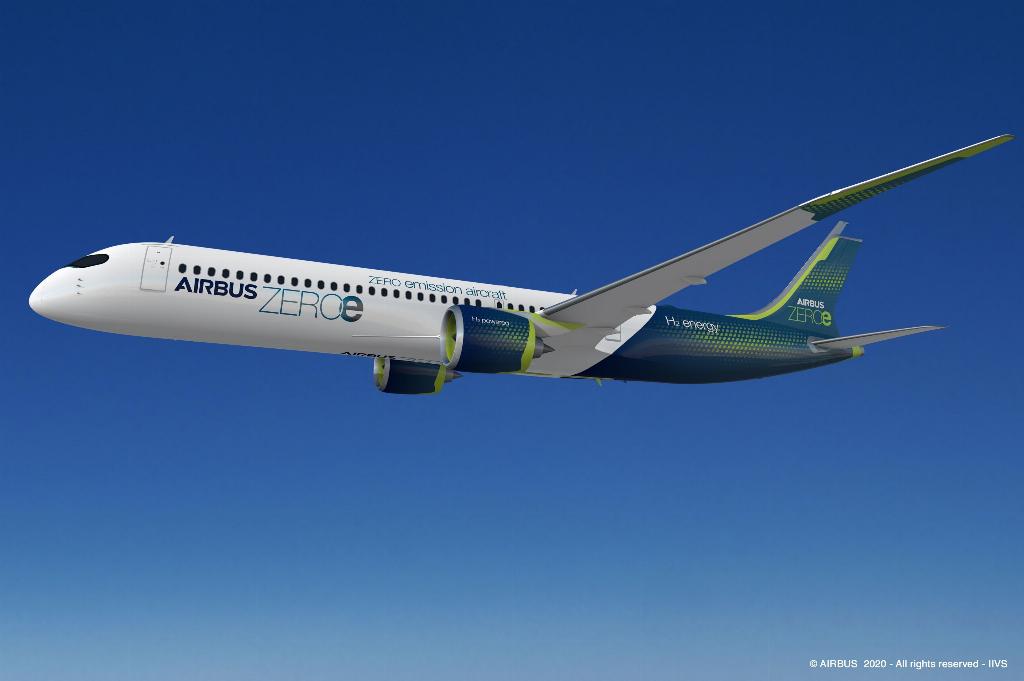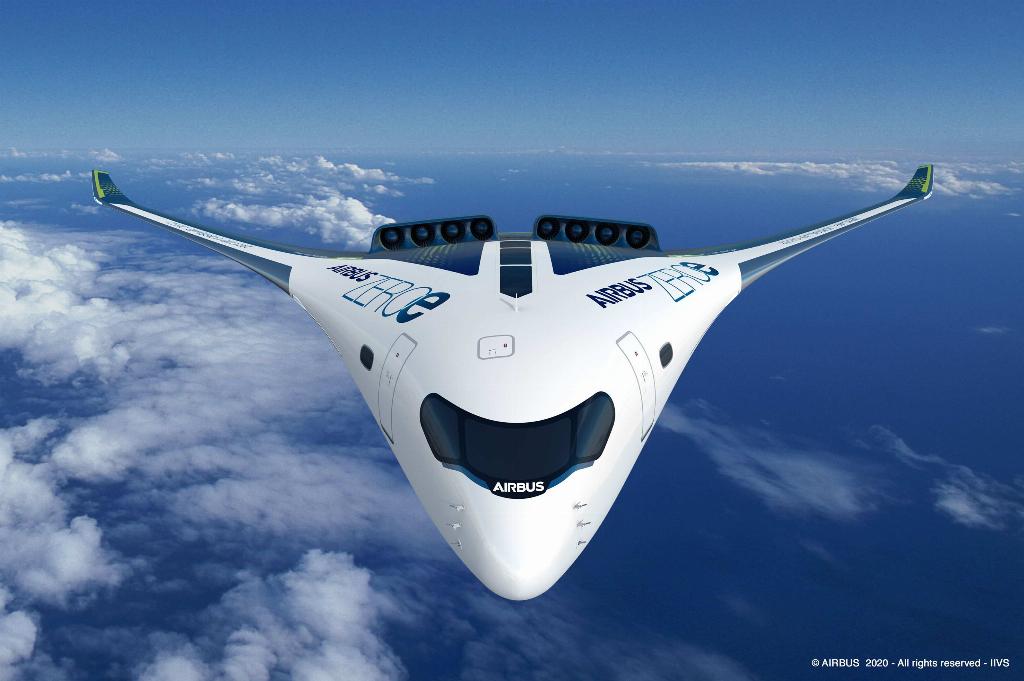Zero-emission concept aircraft nears reality

In a Q&A session, Glenn Llewellyn, Airbus’ head of zero emissions discusses the company’s new zero-emission Hydrogen ZEROe aircraft concepts and its leading role in the most important transition this industry has ever seen.
In a Q&A session, Glenn Llewellyn, Airbus’ head of zero emissions discusses the company’s new zero-emission Hydrogen ZEROe aircraft concepts and its leading role in the most important transition this industry has ever seen.
Airbus recently revealed three concepts for the world’s first zero-emission hydrogen commercial aircraft which could enter service by 2035. These concepts each represent a different approach to achieving zero-emission flight, exploring various technology pathways and aerodynamic configurations in order to support the Company’s ambition of leading the way in the decarbonisation of the entire aviation industry.

All of these concepts rely on hydrogen as a primary power source - an option which Airbus believes holds exceptional promise as a clean aviation fuel and is likely to be a solution for aerospace and many other industries to meet their climate-neutral targets.
Q) Hydrogen as an aircraft fuel has been explored before. What changes to current technology made you think it is now a viable alternative to kerosene?
We see hydrogen as one of the most promising solutions that could contribute >50% towards meeting climate-neutral targets. It’s not a new technology, but a lot of progress has been made in other industries.
Beyond the technology challenges, the aviation industry’s transition to renewable hydrogen will require the regulatory and infrastructure ecosystems to change. Airports will require significant hydrogen transport and refuelling infrastructure to meet the needs of day-to-day operations.
Cross-industry collaboration will be required to drive down infrastructure and production costs, which will be mutually beneficial and help speed up development of the hydrogen economy. We must therefore continue to push forward with the production and uptake of sustainable aviation fuels, which are an integral part of an aviation decarbonisation strategy.
We will only succeed if all industries choose a pathway towards the Paris Agreement so, collectively, we could scale up renewable energy and hydrogen at a massive scale.
Q) Why have you created three concept aircraft? Wouldn’t it be easier just to concentrate on one?
We’re not talking about concrete new aircraft programmes here but about concepts to illustrate our ambition, and illustrate how this future zero-emission aircraft could look like. We are working on three different hydrogen-powered ‘ZEROe’ concept aircraft:
A ‘turbofan’ design (<200 passengers) powered by hydrogen, rather than jet fuel, through combustion with a range of 2,000+ nautical miles, operating intercontinentally.
A ‘turboprop’ design (capacity of up to 100 pax) with a turboprop engine instead of a turbofan also powered by hydrogen combustion in modified gas-turbine engines. Target range 1,000+ nautical miles, making it a perfect option for short-haul trips.
A ‘blended-wing body’ (<200 passengers) that due to its wide cabin layout opens up multiple options for hydrogen storage and distribution. For the moment we are pursuing the idea of cryogenic storage tanks underneath the wings. Passenger capacity and range the same as for the single-aisle concept.
All three ZEROe aircraft are exciting concepts and offer a lot of advantages for future air travel. Over the next few years, we will refine each concept to make sure we have matured the technology enough to deliver on our zero-emission ambition.
Q) Would you say the turbo-prop version is designed primarily for short-haul flights such as those around Europe or internally in the US? Would there be a speed reduction factor with that aircraft and do you think that is a trade-off that passengers will be happy to make for greener, more sustainable aviation?
Indeed, the ‘turboprop’ design, also powered by hydrogen combustion in modified gas-turbine engines, has a target range of 1,000+ nautical miles, making it a perfect option for short-haul trips. Turboprops do fly slower than jet aircraft, but we don’t think it should matter to passengers for short-haul trips.
Q) Would you say storage and safety is the biggest challenge when it comes to using hydrogen? How can these issues be overcome?
Storage and safety are a big challenge we are facing with hydrogen. It is mandatory to achieve the same or better safety targets than what we achieve with existing commercial aircraft. Hydrogen is safe and non-toxic. It is no more or less dangerous than other fuels, including gasoline and natural gas.

The technology we use to achieve the safety targets will for sure be different, e.g. twin-walled vacuum-insulated tanks for hydrogen storage instead of kerosene inside the wings. Nonetheless, with these new technologies and the massive cross-industry experience of handling hydrogen, we see the safety targets as being fully achievable.
Q) What future or ratio of composites and metals/advanced alloys do you foresee being used in these aircraft? What are the main areas where even more weight can be reduced?
It’s too early to talk about a ratio of composites and metals/advanced alloys on our zero-emission aircraft, but we are indeed looking at future materials, not only to reduce the weight of the aircraft, but also materials that capture carbon (such as composites made out of algae and bamboo fibres) and which are easily recycled. We’re looking at the full lifecycle of the aircraft.
Q) Do you think additive manufacturing technologies will make much of a contribution to this programme? How good are modern simulation technologies to enable a faster route to full scale production?
Additive manufacturing technologies are interesting and we’re looking carefully at them. We have introduced additive manufacturing already for polymer technology. They are also relevant for fast and cheap prototyping of wind tunnel models and manufacturing tooling for example.
Q) How are you working with engine suppliers to enable development of new combustion engines and other power sources such as fuel cells?
Airbus is currently exploring the potential of hydrogen combustion aircraft. These aircraft can be hybridised efficiently with fuel cells instead of batteries because we already have hydrogen on-board. All solutions require us to work with engine manufacturers who will have a huge role in bringing hydrogen to commercial aircraft.
Q) What does this mean for purely electric forms of flight? Do they have any future? Similarly, what about biofuels, SAF etc.?
Sustainable aviation fuel (SAF) is an extremely important part of the aviation roadmap to reduce our industry’s CO2 emissions, as it plays a key role in an effective carbon-reduction programme because all existing aircraft can already run on a SAF blend of up to 50%.

Electrification is still a relevant pathway we’re exploring. E-Fan X, our last electric propulsion demonstrator, is an important milestone in our decarbonisation journey. Every successful milestone in electric flight has taken us one step closer to future certification of a commercial aircraft based on alternative propulsion.
Q) How will you help the wider aviation industry build the infrastructure needed for this radical change in fuel/power source type?
Airbus is already spending hundreds of millions on the zero-emission ambition. Overall, the order of magnitude for a programme of this type is several billions of Euros. Even though Airbus will invest a lot in transition to sustainable energy, we will not succeed alone, but with:
Airlines - We have signed a Memorandum of Understanding (MoU) with airlines like SAS Scandinavian and easyJet airlines for hybrid and electric aircraft eco-system and infrastructure requirements research projects.
Airports - We have already started working with airports on the concept of ‘Airport Hydrogen Hub’.
The plan is to develop a stepped approach, including using hydrogen to decarbonise all airport-associated ground transport in the 2020 to 2030 timeframe.
Governments in France, Germany, Spain and the UK - We’re in close relationships with governmental agencies of Airbus’ European home countries to set up research partnership projects to start before the end of 2020 or 2021. These new research projects will boost industrial and academic eco-systems towards Airbus zero-emission initiative.
The European Union - Aviation must be included in the EU Hydrogen Strategy and Roadmap.
It’s essential to set an action plan that delivers on objectives for aviation before 2030, in full coordination with the Clean Aviation Partnership SRIA (Strategic Research and Innovation Agenda) and innovation chain.
Q) You have set an ambitious target of introducing these aircraft by 2035. The change could be compared to trains changing from steam to diesel/electric power forms, is this a realistic goal and timeframe?
Our timeline is ambitious, but our conviction is strong! We believe the technologies required to power a zero-emission aircraft will be mature enough for a target entry-into-service date of the mid-2030s.
In order to meet the 2035 target, we would need to launch a programme by 2026-2028, which means we have about five years to mature all the required technologies before we do so.













